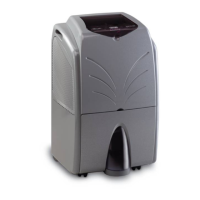
Do you have a question about the DeLonghi DE320GB and is the answer not in the manual?
| Moisture Removal | 12 liters per day |
|---|---|
| Water Tank Capacity | 2 liters |
| Dehumidification Capacity | 12 liters per day |
| Tank Capacity | 2 liters |
| Operating Temperature Range | 5°C to 35°C |
| Weight | 10.5 kg |
Highlights the rapid dehumidification feature of the appliance.
Emphasizes the appliance's dual function for dehumidifying and heating.
Details the available heating power settings for the appliance.
Covers features like Humidistat and Thermostat for precise control.
Notes the comfort settings and quiet operation of the unit.
Mentions the inclusion of an air purification filter.
Explains the appliance's ability to eliminate condensate.
Highlights the appliance's portability with ergonomic handles.
Details safety features like overheat protection.
Guidance on seeking technical support and authorized repairs.
Instructions for safe and proper electrical connections.
Procedure for draining condensate directly into the internal tank.
Instructions for setting up continuous external drainage.
Explains the intelligent device for monitoring the water tank status.
Step-by-step guide for operating the dehumidifier.
Instructions for using the appliance's heating function.
Guide for using both dehumidifying and heating functions simultaneously.
Details on activating and using the high-power turbo mode.
Instructions for cleaning the exterior of the appliance.
Guide on how to clean the air filter for optimal performance.
Recommendations for storing the appliance when not in use.
